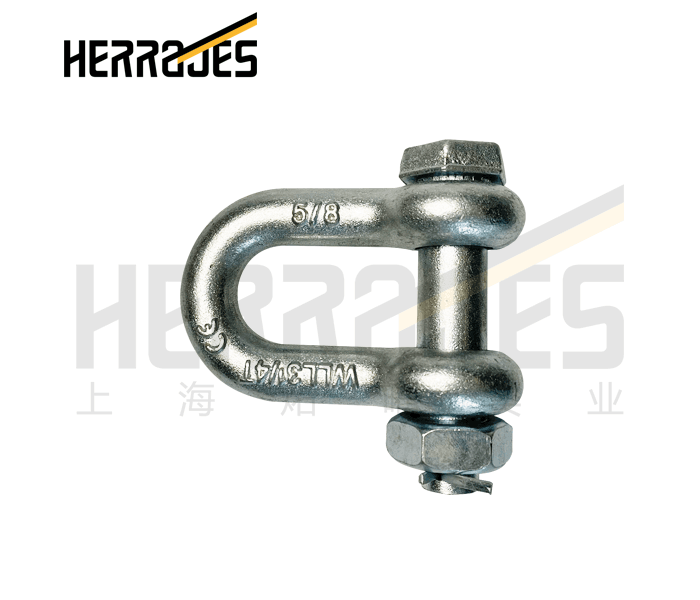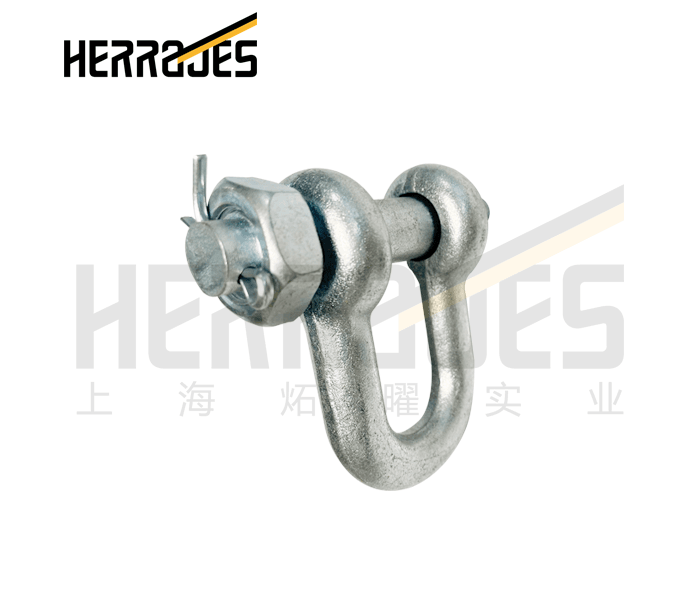Shackles
Shackle (or shackle bolt), also known as lock buckle, is a U-shaped metal plate fixed to the opening with a U-shaped pin or bolt, or a hinge metal ring fixed with a quick release locking pin mechanism. This term also applies to handcuffs and other similar designed restraint devices that function in a similar manner. Shackles are the main connecting link of various rigging systems, from ships and vessels to industrial crane rigging, as they allow for quick connection or disconnection of different subsets of rigging. Shackles are also similar shaped metal pieces used in conjunction with locking mechanisms in padlocks. Mountaineering buckle is a type of buckle used in mountaineering.
Type editing
Bow shaped shackle
Due to the large O-ring of the ring, this type of shackle can withstand loads from multiple directions without generating such a large lateral load. However, the larger shape of the ring does indeed reduce its overall strength. Also known as anchor shackle.
D-shaped shackle
D-shaped shackle, also known as chain shackle, is a narrow shackle shaped like a chain link, usually with a pin or threaded pin closure. D-shaped shackles are very common, and most other types of shackles are variants of D-shaped shackles. The small loop can mainly withstand high loads. Side and shelf loads may distort or bend D-shaped shackles.
Headboard hook
This longer version of the D-shaped shackle is used to connect lifting ropes to sails, especially those equipped with headboards, such as Bermuda sailboats. The headboard hook and loop are usually made of flat stainless steel stamped and have an additional pin between the top and bottom of the loop, so the headboard will not scratch the splicing holes of the lifting cable.
Sales shackle
The anchor bolt and split pin are used to close the shackle in a way similar to a U-clip. For this reason, they are commonly referred to as U-clips in industrial terminology. Sometimes, the shackle may not be convenient to use because the bolt needs to be fixed to the main body of the shackle to avoid loss, usually using a split pin or clamp wire. The safer version used in crane rigging has a combination of fixed nuts (hardware) located next to the split pin. Shackles are practical in many rigging applications, where the anchor bolts are expected to undergo some rotation.
Buckle release
As the name suggests, a snap fastener is a quick fastener that can be operated with one hand. It uses a spring activated locking mechanism to close the hinge buckle and can be released under load. This is a potential security risk, but it can also be very useful at times. A snap buckle is not as safe as any other form of buckle, but it can be used temporarily or in situations where frequent movement or replacement is necessary, such as a sailor’s harness rope or connecting a large triangular sail bed sheet. Note: When this type of shackle is used to release a large load, its working effect will be poor (difficult to release) and it is likely to cause failure of the pin assembly or opening ring.
Threaded shackle
The pin has threads, and one leg of the shackle has threads. The pin may be tethered, which means it fits with the shackle, usually using a single wire. If tightened too tightly or corroded in saline air, threads may wear out, so a large amount of lanolin or thick grease should be applied to any and all threads. Shackle keys or metal marlins are useful tools for loosening nuts.For safety reasons, threaded shackles are usually used to prevent pins from loosening. This is achieved by threading the mouse cable or nylon tie through the hole on the pin and wrapping it around the buckle body. For pins with cross holes on the threaded end, split pins can be used. One drawback of wires is that due to material differences, mice can introduce galvanic corrosion; It is particularly bad when using the buckle in areas exposed to air and water. It is not recommended to use nylon in areas where significant movement of the shackle is expected.
Fried Dough Twists shackle
Twisted shackles are usually slightly longer than the average length and have a 90 degree twist, so the top of the ring is perpendicular to the pin. One of the uses of this type of shackle is to connect the triangular sail lifting rope block to the mast, or to connect the triangular sail lifting rope to the sail, in order to reduce the distortion of the sail and make it better set.
Shackle
Soft Shackle
Modern strong fibers such as PBO (IUPAC name: poly (p-phenylene-2,6-benzobioxazole), aramid (Kevlar, Technora, Twaron, Vectran, carbon fiber), ultra-high molecular weight polyethylene (UHMWPE) – or Dyneema and other synthetic fibers are used to manufacture ultra strong ropes, and can also be tied into lockable rings, known as soft shackles.The soft shackles are better articulated and won’t make a creaking sound when there is no load. They won’t bite off the toe rails or hit the mast and deck, so don’t get hurt when they hit you.



